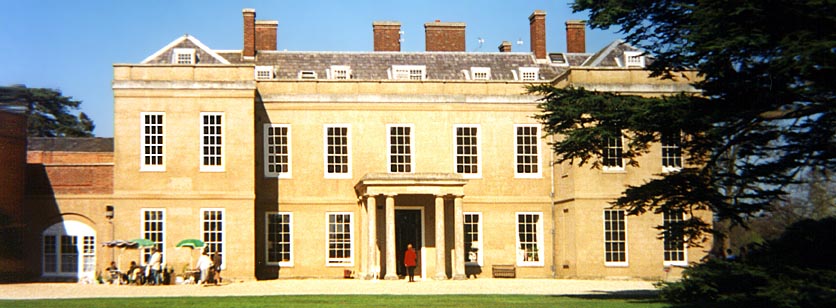 |
 |
|||
|
|
Swallowfield Park The present house at Swallowfield Park, was erected in 1689 by Henry Hyde, the 2nd Earl of Clarendon, for his wife, the Swallowfield heiress, Flower Backhouse. She was the daughter of William Backhouse, the famous alchemist and inventor, whose family had owned the estate since the late 16th century. Their old Tudor mansion had replaced the previous 'castle' of Sir John Despencer who lived here in the 13th century. Clarendon's architect was Tolman, the Controller of the Works to King William III. He built an H-shaped house with short projections to the front and more extended ones to the rear. The exceptional monumental doorway re-erected in the garden was originally the northern entrance to Tolman's house and its finely carved garlands and drapery compare with the best work of the period. Internally little of his house remains for the whole place was much altered by Sir Henry Russell in 1825. He installed the main corridor and had the dining room fashioned out of the old offices. The building's red brick facade was then plastered over and the small portico added. Thus forming what the architect, Atkinson, called "a very handsome Grecian front on the library face". Unfortunately, the installation of a new staircase led to the removal of a richly carved cornice made for the Earl of Clarendon by Grinling Gibbons. An interesting complex of outbuildings on the western side forms a small courtyard which was originally surrounded by an open cloister. The south side was a service area, including a brewery and slaughter house, while the kitchen and laundry were in the north wing. Water was pumped up by a horse attached to a beam, to a storage area under the clock tower, from a deep well in the small private garden. Here too can still be seen a rare one handed clock dated 1757. John Evelyn, the late 17th century diarist, visited the gardens and planted the Yew Walk. Afterwards, he wrote that they were "as elegant as 'tis possible to make a flat by art and industry and no mean expense". He was delighted by "the delicious and rarest fruits [and the] innumerable timber trees in the ground about the seat," the walks and groves of elms, limes, oaks and other trees, the quarters, walks and parterres, the nurseries, the kitchen garden, two noble orangeries and "above all, the canal and fishponds, the one fed with white, the other with a black running water" stocked with pike, carp, bream and trench. The Rivers Whitewater and Blackwater, join just above the Park but divided again briefly as they flow threw it. The little five-arched bridge over the Blackwater, as well as the walled-garden, were built for Thomas 'Diamond' Pitt who purchased the Park from Clarendon Junior in about 1717. The former is said to be haunted by the ghost of a Cavalier soldier from the time of the Civil War; and the Backhouses were certainly Royalists. Not far away is a Pets' Cemetery which includes the grave of Charles Dickens' dog, Bumble. Swallowfield Park is now divided
into private apartments.
|
|||
| © Nash Ford Publishing 2002. All Rights Reserved. | ||||



